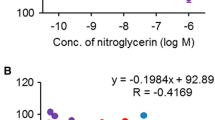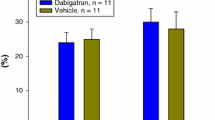Summary
Objectives. To study the effects of oral pretreatment with metoprolol over 3 days on hemodynamics, left ventricular function, regional myocardial blood flow, and infarct size in an anesthetized dog model of thrombotic occlusion of the anterior descending coronary artery treated with thrombolysis.Methods. Ten dogs received 200 mg metoprolol (Selozok) orally and 8 dogs received placebo for 3 days twice daily and 1 hour before the experiment. Under general anesthesia, thrombotic occlusion was provoked by the copper-coil technique. Intracardiac pressures and their derivatives, cardiac output (thermodilution method), regional coronary blood flow (microspheres), global and regional left ventricular function (ventriculography), and infarct size (triphenyltetrazolium staining) were measured. Measurements were performed during control, after 60 minutes of occlusion, and after 30 and 90 minutes of reperfusion. Thrombolysis was performed in all dogs 60 minutes after occlusion by intravenous infusion of 10 µg/kg/min of rt-PA for 30 minutes.Results. During control cardiac output was lower, total peripheral resistance higher, and Tau and the left ventricular isovolumic relaxation time greater in the metoprolol group. During occlusion and after reperfusion, there were no significant hemodynamic differences between both groups. Blood flow to the area at risk and circumflex territory during occlusion were, respectively, 12.8±5.80 ml/100 g/min versus 9.65±8.35 ml/100 g/min (p>0.05) and 42.58±7.86 ml/100 g/min versus 61.52±20.43 ml/100 g/min (p=0.01) in the metoprolol- and placebo-treated dogs. The ratios of flow area at risk/circumflex territories in the epicardial, midmyocardial, and endocardial layers were, respectively, 0.44±0.20, 0.19±0.09, and 0.20±0.13 in the metoprolol- versus 0.24±0.16, 0.08±0.06, and 0.06±0.07 (p≥0.04) in the placebo-treated dogs. The ratio of flow endocardium/epicardium was higher (p≥0.02) in the active treatment group during the control period, both in the area at risk and circumflex territory; this was also the case in the circumflex territory at the end of the experiment (p=0.003). Thirty minutes after occlusion, blood flow to the three layers of the area at risk rose to 2–3 times control values in both groups; a significant increase above control values also occurred in the circumflex territory. After 90 minutes reperfusion, blood flow to both territories was similar in both groups but was comparable to the control; however, in necrotic tissue of the subendocardial layer of both groups, flow fell below control values (p<0.05). End-systolic volume rose from 21.2±7.4 ml to 36.1±11.5 ml (p<0.05), end-diastolic volume remained constant (46.0±13.8 vs. 47.9±12.1 ml; p>0.05), and ejection fraction fell from 53.9±8.3% to 25.8±10.2% (p<0.05) at the end of the experiment in the metoprolol group. Respective figures for the placebo group were 19.4±7.9 versus 27.9±10.9 (p<0.05), 38.5±13.0 versus 42.1±11.0 (p>0.05), and 50.6±5.7 versus 35.5±11.7 (p<0.05). Fractional shortening of the chords analyzed was similar in both groups during the control period; it fell significantly at the end of the experiment in three chords of the metoprolol group and in five chords of the placebo group. The apical chord in the placebo, but not in the metoprolol, dogs was dyskinetic: fractional shortening was −0.86±9.7 versus 7.5±13.5% (p>0.05). The area at risk was 41.6±10.6 cm2 in metoprolol- and 40.5±7.2 cm2 in placebo-treated dogs (p>0.05); the infarct size, expressed as a percentage of the area at risk, was 29.0±22.5% and 45.3±23.6% (p=0.02), respectively.Conclusions. Oral pretreatment with metoprolol limited infarct size and improved regional left ventricular function, probably due to its negative chronotropic and inotropic effects, and also due to an enhancement of collateral flow from the circumflex territory to the area at risk.
Similar content being viewed by others
References
Reimer KA, Rasmussen MM, Jennings RB. Reduction by propranolol of myocardial necrosis following coronary artery occlusion in dogs.Circ Res 1973;33:353–363.
Lange R, Kloner R, Braunwald E. First ultra-short-acting beta-adrenergic blocking agent: Its effect on size and segmental wall dynamics of reperfused myocardial infarcts in dogs.Am J Cardiol 1983;51:1759–1767.
Hammerman H, Kloner RA, Briggs LL, Braunwald E. Enhancement of salvage of reperfused myocardium by early beta-adrenergic blockade (Timolol).J Am Coll Cardiol 1984;3:1438–1443.
Van de Werf F, Vanhaecke J, Jang IK, et al. Reduction in infarct size and enhanced recovery of systolic function after coronary thrombolysis with tissue-type plasminogen activator combined with beta-adrenergic blockade with metoprolol.Circulation 1987;75:830–836.
Jang IK, Van de Werf F, Vanhaecke J, De Geest H. Coronary reperfusion by thrombolysis and early beta-adrenergic blockade in acute experimental myocardial infarction.J Am Coll Cardiol 1989;14:1816–1823.
Sarnoff SJ, Braunwald E, Welch GH, et al. Hemodynamic determinants of oxygen consumption of the heart with special reference to the tension-time index.Am J Physiol 1958;192:148–156.
Buckberg G, Fixler D, Archie J, Hoffman JIE. Experimental subendocardial ischemia in dogs with normal coronary arteries.Circ Res 1972;30:67–81.
Kasser IS, Kennedy JW. Measurement of left ventricular volumes in man by single-plane cineangiocardiography.Invest Radiol 1969;4:83–90.
Leighton RF, Wilt SM, Lewis RP. Detection of hypokinesis by a quantitative analysis of left ventricular cineangiograms.Circulation 1974;50:121–127.
Jang IK. Coronary reperfusion and beta-adrenergic blockade in acute myocardial infarction. An angiographic evaluation of left ventricular function. Doctoral thesis.Acco (Leuven) 1987;44.
Flameng W, Winkler B, Wusten B, et al. Minimum requirements for the measurement of regional myocardial flow using tracer microspheres.Bibl Anat 1976;15:24–29.
Kordenat RK, Kezdi P, Stanley EL. A new catheter technique for producing experimental coronary thrombosis and selective coronary visualization.Am Heart J 1972;83:360–364.
Corday AE, Lang TW, Meerbaum S. Closed chest model of intracoronary occlusion for study of regional cardiac function.Am J Cardiol 1974;33:49–59.
Mueller NS, Ayres SM. The role of propranolol in the treatment of acute myocardial infarction.Progr Cardiovasc Dis 1977;19:405–412.
Vatner SF, Baig H, Manders WT, et al. Effects of propranolol on regional myocardial function, electrograms and blood flow in conscious dogs with myocardial ischemia.J Clin Invest 1977;60:353–360.
Frishman WH. Multifactorial actions of beta-adrenergic blocking drugs in ischemic heart disease: Current concepts.Circulation 1983;67(Suppl I):11–18.
Becker LC, Fortuin NJ, Pitt B. Effect of ischemia and anti-anginal drugs on the distribution of radioactive microspheres in the canine left ventricle.Circ Res 1971;28:263–269.
Fox K, Welman E, Selwyn A. Myocardial infarction in the dog: Effects of intravenous propranolol.Am J Cardiol 1980;45:769–774.
Pitt B, Craven P. Effect of propranolol on regional myocardial blood flow in acute ischemia.Cardiovasc Res 1970;4:176–179.
Flameng W, Xonneux R, Vanhaecke J, et al. Prevention of the “no-reflow” phenomenon in the canine heart by mioflazine.Basic Res Cardiol 1985;80:27–36.
Vanhaecke J, Flameng W, Borgers M, Jang IK, Van de Werf F, De Geest H. Evidence for decreased coronary flow reserve in viable postischemic myocardium.Circ Res 1990;67:1201–1210.
Ollson RA, Bugni WJ. Coronary circulation. In: Fozzard HA, et al., eds.The Heart and Cardiovascular Systems. New York: Raven Press, 1986:987–1038.
Feigl ED. Reflex parasympathetic coronary vasodilation elicited from cardiac receptors in the dog.Circ Res 1975;37:175–182.
Jarish A, Zotterman Y. Depressor reflexes from the heart.Acta Physiol Scand 1948;16:31–51.
Grayson J, Levine M, Parratt JR, Cunningham J. Vasospastic elements in myocardial infarction following coronary artery occlusion in the dog.Cardiovasc Res 1968;2:54–64.
Rubio R, Berne RM, Doleson JG. Release of adenosine in reactive hyperemia of the dog heart.Am J Physiol 1969;216:56–62.
Grines CL, Booth DC, Nissen SE, Gurley JC, Bennett KA, DeMaria AN. Acute effects of parenteral beta-blockade on regional ventricular function on infarct and noninfarct zones after reperfusion therapy in humans.J Am Coll Cardiol 1991;17:1382–1387.
Young MA, Vatner SF. Regulation of large coronary arteries.Circ Res 1986;59:579–596.
Vatner DE, Knight DR, Homey CJ, et al. Subtypes of beta-adrenergic receptors in bovine coronary arteries.Circ Res 1986;59:463–473.
Feldman RD, Christy JP, Paul ST. Beta-adrenergic receptors on canine coronary collateral vessels: Characterization and function.Am J Physiol 1989;257:H1634-H1639.
Kloner RA, Fishbein MC, Cotran RS, et al. The effects of propranolol on microvascular injury in acute myocardial ischemia.Circulation 1977;55:872–880.
Reynolds RD, Burmeister WE, Gorczynski RJ, et al. Effects of propranolol on myocardial infarct size with and without coronary artery reperfusion in the dog.Cardiovasc Res 1981;15:411–420.
Vick-Mo H, Maroko PR, Ribeiro LGT. Comparative effects of propranolol, timolol and metoprolol on myocardial infarct size after experimental coronary artery occlusion.J Am Coll Cardiol 1984;4:735–741.
Van de Werf F, Janssens L, Brzostek T, et al. Short-term effects of early intravenous treatment with a β-blocker or a specific bradycardiac agent in patients with acute myocardial infarction receiving thrombolytic therapy.J Am Coll Cardiol 1993;22:407–416.
Roberts R, Roger WJ, Mueller NS, et al. for the TIMI investigators. Immediate versus deferred β-blockade following thrombolytic therapy in patients with acute myocardial infarction. Results of the Thrombolysis in Myocardial Infarction (TIMI) II-B Study.Circulation 1991;93:422–437.
Author information
Authors and Affiliations
Rights and permissions
About this article
Cite this article
Zmudka, K., Dubiel, J., Vanhaecke, J. et al. Effects of oral pretreatment with metoprolol on left ventricular wall motion, infarct size, hemodynamics, and regional myocardial blood flow in anesthetized dogs during thrombotic coronary artery occlusion and reperfusion. Cardiovasc Drug Ther 8, 479–487 (1994). https://doi.org/10.1007/BF00877926
Received:
Accepted:
Issue Date:
DOI: https://doi.org/10.1007/BF00877926




